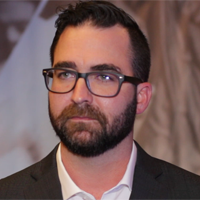OTT Ad Tech Gets A ‘C’ For Pandemic Performance
Even with surging audiences, it’s clear that broadcasters’ OTT products are a work in progress, especially when it comes to the ad tech associated with it.
Though this new frontier carries a brighter revenue promise than other digital platforms, executives say revenue opportunities are being left on the table in OTT.

Michael Senzon
“TV doesn’t have nearly the amount of data we have,” said Michael Senzon, SVP and GM of the OTT channel Local Now. “We have the capability of targeting; we should be able to get all these pipes clean. The thing that’s frustrating to me is the lack of confidence, almost, in it.”
Senzon expressed that frustration in a Thursday panel discussion, which he moderated, at TVNewsCheck’s OTT News Summit titled “Ad Tech Pandemic Report Card.” Senzon and three other OTT leaders handed out grades to the industry, judging the advancements — or, perhaps, a lack thereof — in ad tech across the many digital delivery systems this past year.
Senzon said that the state of OTT ad tech “drives me bananas,” and asked the panel what grades they felt the industry has earned in respect to ad tech growth during the pandemic — an unfortunate crisis that, by all account, has been a boon to OTT viewership.

Blake Sabatinelli
“If I was to give a grade right now, I’d give it a strong C-plus, maybe a B-minus if I was being generous,” said Blake Sabatinelli, CEO of Newsy. “The pandemic has really changed things for us as news organizations, especially those that focused on the OTT side of the business, because it’s changed the perception of what the inventory is and the ad community, and has caused a pretty significant influx of dollars to come in.”
As a result of this shift, Sabatinelli continued, publishers with such capabilities are “making advancements in how they do delivery, how they do creative separation, how they handle things like ad repetition.”
Sabatinelli conceded that there have been improvement in ad tech this past year. “But the reality is we’re still a pretty far way off from where we need to be. There’s challenges that exist in those three items that I think are first and foremost, and until we address those in a capacity that allows us to ensure that people are comfortable bringing all of their TV dollars to us, we’re going to continue to have headaches.”

Tony Katsur
Tony Katsur, SVP of digital strategy, corporate development and operations for Nexstar Media group, took a three-fold approach to his grade.
“I think [with] execution and delivery of an OTT ad campaign, I’d give it an ‘A’; most players have performed admirably in that sense,” Katsur said. Echoing some of Sabatinelli’s points about consistency, Katsur said: “In reporting and attribution in developing a common currency around audience, I would give the industry an ‘F.’ ” He added that in “planning and buying tools, I would give them a solid C-plus to B-minus.”
Senzon noted that Katsur’s combined grade rounded out to about what Sabatinelli provided, and Chris Garcia, VP of ad ops at CBS Local Digital Media, provided a grade of “a solid ‘C,’ ‘needs improvement.’
“With the pandemic increasing the value of OTT impressions and inventory, it really forced the business to be more mature than the tech can support,” Garcia said, relieving the industry of some of the responsibility. “It was really one of these things where we had to ramp up quickly to deal with the scale that we hadn’t intended and the stickiness of the audience. Now we’re just trying to improve the value in the product and catch up with the popularity of these platforms.”
The report card grades were telling, but Senzon wanted to know, “How do we get to an ‘A’?”

Chris Garcia
“In order for us to get to an ‘A,’ we have to meet the agencies, and the advertisers and even our audiences where they are,” Garcia said. He suggested that “consistent KPIs,” which can be measured across platforms, “is really the thing that’s holding us back from evolving the business into something we can truly have confidence in.”
But Garcia has observed that, because the space is fraught with fragmentation in seemingly every corner, publishers are “unable to really measure apples to apples.
“Digital is supposed to be that advanced medium where we have more data points and we have more things to measure and can show different types of success,” Garcia said. “We’re just not there yet; it’s not consistent. Until we have that consistent currency it’s gonna be that Wild West scenario where we’re trying to measure things individually, in presenting fragmented data back to our advertisers.”
Sabatinelli admitted to frustration with the lack of progress in ad tech data insights, too. “We need Nielsen ratings — or something of the equivalent manner — to get people comfortable with a single measurement style,” he said.
Newsy appeals to a national audience, so “everything for us is impressions anyway,” Sabatinelli said. “But that doesn’t change the fact that in order for me to deliver a campaign across my footprint of [around] 76 distribution points right now… I have to funnel all of that into a Nielsen marketing cloud, through an integration, which is a tremendous pain in my ass, and technically not possible in many cases. [Then,] have that rated in some kind of single currency and deliver that back.”
Without a consistent measurement currency, viewers’ streaming ad experience is being impaired by the fragmented data reported back to advertisers. “We need Nielsen ratings or something of the equivalent manner to get people comfortable… Click To TweetFor all of the streaming ecosystem’s complications, Katsur said we need to remember the simplicity of its value proposition.
“It is still TV at the end of the day, delivered over a different, highly addressable pipe,” Katsur said. “We need to stop applying digital metrics to OTT; OTT is just television delivered over the IP protocol. And it can be on demand or you can live stream it, but it’s still a lean-back television experience and it needs to be thought of that way on behalf of the consumer, and ads need to be bought and sold that way on behalf of the consumer.”
Find more OTT News Summit coverage here.

































Comments (0)